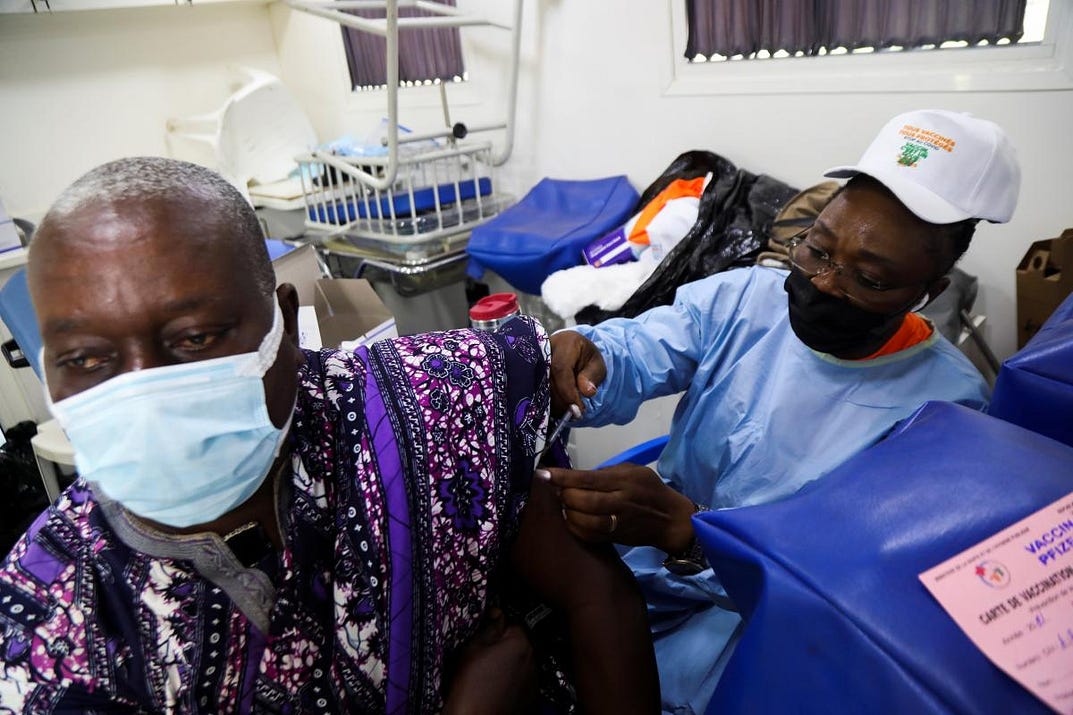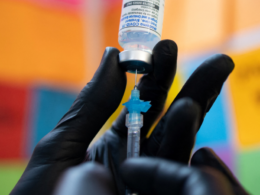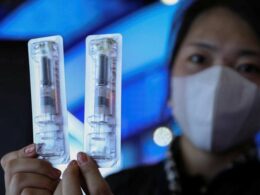1.Relying on population-wide vaccination is not working.
2.Other treatments seem more promising.
3.Rich countries must make smarter investments in poorer ones
SmartHealth Blog
Joaquim Cardoso MSc. (Chief Editor)
January 21, 2022
dw
This is a synthesis of the article below (How to Prevent COVID’s Next Comeback @ Foreign Affairs), with the title above, edited by the author of this blog. We focused on the recommendations of the publication. For details about the 3 recommendations, refer to the original publication.
What is the situation of the pandemic, looking backwards?
- During the first year of the pandemic, most people believed the world had a shot at eradicating COVID-19.
- Now, it’s clear this is not possible.
- Early in 2020, when there were no COVID-19 vaccines or treatments, most countries were able to mount a vigorous pandemic response through nonpharmaceutical interventions
What are the regions lagging behind in vaccination (globally) ?
According to the projections of Our World in Data, there are three large regions that are not on track to fully vaccinate 70 percent of their population by mid-2022.
- One includes almost all of Africa.
- The second stretches from eastern Europe to Syria.
- But the third is the United States, where, despite widespread vaccine availability, only 62 percent of the population has received their first dose.
The implication, however, is that the United States might be twice responsible for what the pandemic is doing in the developing world: first by hoarding vaccines for its own population, and then by not actually using those doses.
- This leaves many millions of U.S. residents susceptible to contracting and transmitting COVID-19, allowing it to mutate.
- This means that even if enough doses finally reach Africa and other poorer parts of the world, these places will still remain vulnerable to new variants coming from the United States.
Managing the new normal of endemic COVID-19 in low- and middle-income countries is a different challenge from controlling the pandemic in developed states.
What was the business case for the 2021 proposal for vaccinating the whole world? Why did the reach countries failed in helping the poor countries at the time, if it was in their economy interest?
- Early in the pandemic, wealthy countries did not mobilize enough of their resources-such as vaccines, protective gear, and oxygen-to help developing states.
- In May 2021, the International Monetary Fund (IMF) managed to line up all the major international organizations behind a plan priced at a modest $50 billion to vaccinate most of the globe over the next two years, and made a persuasive economic case for it.
- They argued this would save the world economy about $9 trillion, mostly by just preventing interruptions to commerce.
- It is still very difficult to understand why rich states failed to widely distribute vaccines.
- Sadly, the Delta variant fueled deadly waves among unvaccinated people everywhere.
What is the situation now with Omicron?
- The current Omicron wave is the final nail in the coffin of hope that COVID-19 was a shock to be overcome, rather than a durable disease that will change how the world works.
- For the moment, eliminating the virus is a pipe dream, and nothing guarantees that the next variant will not be more dangerous than the current one.
What are the recommendations?
What does a world where COVID-19 is endemic mean for prevention and mitigation in Africa, South Asia, Southeast Asia, or the poorer parts of South America? Ultimately, the answer will depend on future mutations and how severe the disease is for people whom they infect.
But we can attempt to answer this question for the type of strains that exist today, where the disease is most severe for older people and for those with preexisting conditions, such as diabetes.
- First, it’s clear that relying on population-wide vaccination is not a feasible strategy.
- Second, treatments seem to be much more promising.
- Third, lower- and middle-income countries cannot afford to continue living in a perpetual state of crisis.
Conclusion
- This is hardly the COVID-free world that many (including the two of us) imagined when the pandemic first broke out.
- The world will have to adjust to a new normal, one that’s a little bit worse than the old normal.
- But hopefully, it will be less anxiety-ridden than what we live with now.
ORIGINAL PUBLICATION

How to Prevent COVID’s Next Comeback
Rich Countries Must Make Smarter Investments in Poorer Ones
Foreign Affairs
By Abhijit Banerjee and Esther Duflo
January 21, 2022
Getting vaccinated in Abidjan, Côte d’Ivoire, September 2021
Luc Gnago / Reuters
During the first year of the pandemic, most people believed the world had a shot at eradicating COVID-19.
Now, it’s clear this is not possible.
There are ebbs and flows in the progression of a virus, so COVID-19 might yet go away, or it might become mild enough to be irrelevant, which seems to be the optimistic discourse right now. But if COVID-19 does fade, it won’t be because of anything people did. Rapid mutations and imperfect inoculations mean that the virus is in charge, at least for now.
Public health experts have come to terms with what that means for the United States and Europe, from permanent widespread testing to routine vaccinations. But it will be just as important that experts and policymakers figure out how less affluent parts of the world can live with this illness.
Early in the pandemic, wealthy countries did not mobilize enough of their resources-such as vaccines, protective gear, and oxygen-to help developing states. The result has been inadequate access to treatments, millions of unnecessary deaths, depressingly few inoculations, and a sequence of dangerous new variants. Silly as it sounds, the world may have sleepwalked into this disaster, not because anyone wanted it, but because nobody-particularly the United States and Europe-got around to exercising the leadership needed to stop it.
Managing the new normal of endemic COVID-19 in low- and middle-income countries is a different challenge from controlling the pandemic in developed states. This is partly because poorer countries lack some of the public health infrastructure and resources needed to effectively protect their populations. But it’s also because recent history suggests that rather than helping, the rich world in general and the United States in particular may be making matters worse for developing countries through their own disastrous management of the disease.
WISHFUL THINKING
Early in 2020, when there were no COVID-19 vaccines or treatments, most countries were able to mount a vigorous pandemic response through nonpharmaceutical interventions. As scientists learned fairly quickly, masking and mobility restrictions were effective against the propagation of the virus. These measures were not ideal, since they could not be sustained over the long run, and there are cases, such as India in the spring of 2020, where they might have been applied with too much force. But the measures offered security while countries waited for vaccines and treatments — which came faster than many predicted. By the end of that year, several highly effective vaccines had been developed and approved in record time. Massive investment in production capacity had started even before the research was completed, which means that millions of doses came online faster than ever before.
This was a moment of great optimism. Rich states and international institutions made all the right noises about the need for vaccine equity. Widespread distribution of vaccines was clearly both the right moral decision and sensible from a purely self-interested perspective. Without widespread vaccination, the disease would keep circulating, mutating, and threatening those in the West who could not or would not get inoculated. Major international institutions launched the COVAX initiative to ensure that vaccines would be purchased and delivered to the entire world. On January 1, 2021, we toasted the new year with a sigh of relief.
And then, at some point in the spring, we started to become despondent.
Although COVID-19 case rates had receded in the United States and other rich nations, the world had neglected to properly help developing countries. Wealthy governments and organizations moved inexcusably slowly in shipping vaccines out to the world, leaving the virus ample space to mutate and mount a ferocious return. Starting in April, India was battered by a brutal second wave fueled by a new variant, eventually named Delta, illustrating precisely the danger of having large pockets of unvaccinated or partially vaccinated people. In May, as the Western world watched in horror and pity what was happening in India, we wrote an article in The New York Times predicting that the Indian crisis was about to become the world’s crisis.
Sadly, we were right-the Delta variant fueled deadly waves among unvaccinated people everywhere. In the United States, where early enthusiasm for vaccination gave way to skepticism among many, there was a large reservoir of unvaccinated people. By July 4, 2021, when U.S. President Joe Biden declared, “we’ve gained the upper hand against this virus,” we were already quite sure that this was wishful thinking. Indeed, the Delta variant fueled a deadly summer wave in the United States.
FAILED STATES
The current Omicron wave is the final nail in the coffin of hope that COVID-19 was a shock to be overcome, rather than a durable disease that will change how the world works. This is both because Omicron is highly virulent and because it clearly shows that, as long as enough people remain unvaccinated, the virus has too many chances to multiply and mutate for any of the available vaccines to remain highly protective against all future possible variants.
For the moment, eliminating the virus is a pipe dream, and nothing guarantees that the next variant will not be more dangerous than the current one.
It is still very difficult to understand why rich states failed to widely distribute vaccines.
As development economists, we have a hard time not feeling angry. Scientists and companies developed several vaccines very rapidly with help from their governments, and it is unconscionable that rich states missed the chance to distribute them across the world.
In May 2021, the International Monetary Fund (IMF) managed to line up all the major international organizations behind a plan priced at a modest $50 billion to vaccinate most of the globe over the next two years, and made a persuasive economic case for it.
They argued this would save the world economy about $9 trillion, mostly by just preventing interruptions to commerce.
The response at the G-7 meeting that followed in June was deafening silence — members committed to essentially nothing.
That meeting may have marked the lowest point in the West’s handling of the pandemic. Indeed, it might be seen in the future as a turning point in the relationship between the rich and poor worlds-the moment where the wealthiest countries quite clearly opted to turn their backs on everyone else. By the time the plan came out, rich states could no longer reasonably claim that their own populations were clamoring for limited vaccine doses, nor could they argue that their own economies were at risk of imploding. And having just spent trillions to prop up their economies, these countries certainly could not say with a straight face that they lacked the money.
It is still very difficult to understand why rich states failed to widely distribute vaccines. How could the world miss such a golden opportunity to do something that would have been self-interested and ethical, as well as a great chance to demonstrate goodwill?
The arguments against feasibility seem feeble: new production capabilities for mRNA vaccines came online rapidly in several countries in Europe and in North America.
It is inconceivable that other countries, including India (the world’s pharmaceutical powerhouse), Indonesia, South Africa, and South Korea, would not have been able to develop similar technologies in a few months had vaccine-producing states in North America and Europe allowed them to — either by lifting intellectual property rights or by transferring the technology directly.
And if they had really wanted to protect their pharmaceutical industries at all costs, rich countries could have just paid manufacturers enough to produce many more vaccines anywhere and then exported them to poorer states.
If these companies had been confident about how much they could sell at full prices, it is quite certain they would have been able to make the necessary investment in production.
Ideally, early in the pandemic, rich countries would have directly financed enough investment in production capabilities for the whole world, just as they did for their own needs.
But manufacturers had no funds and no economic compulsion to do so, and no other urge seemed strong enough to move them.
At some level, however, all this may be moot. It was probably too optimistic for anyone to have believed that a rapid worldwide vaccination drive would be enough to tame the virus.
According to the projections of Our World in Data, there are three large regions that are not on track to fully vaccinate 70 percent of their population by mid-2022.
- One includes almost all of Africa.
- The second stretches from eastern Europe to Syria.
- But the third is the United States, where, despite widespread vaccine availability, only 62 percent of the population has received their first dose.
… there are three large regions that are not on track to fully vaccinate 70 percent of their population by mid-2022… the third (region) is the United States, where, despite widespread vaccine availability, only 62 percent of the population has received their first dose.
This leaves many millions of U.S. residents susceptible to contracting and transmitting COVID-19, allowing it to mutate. (The booster campaign is also moving very slowly; so far, 35 percent of the fully vaccinated population has received an additional shot.)
This means that even if enough doses finally reach Africa and other poorer parts of the world, these places will still remain vulnerable to new variants coming from the United States.
How and why the country landed in this situation is the topic of another essay.
The implication, however, is that the United States might be twice responsible for what the pandemic is doing in the developing world: first by hoarding vaccines for its own population, and then by not actually using those doses.
… the United States might be twice responsible for what the pandemic is doing in the developing world: first by hoarding vaccines for its own population, and then by not actually using those doses.
WHAT WORKS
But enough of the blame game.
What does a world where COVID-19 is endemic mean for prevention and mitigation in Africa, South Asia, Southeast Asia, or the poorer parts of South America?
Ultimately, the answer will depend on future mutations and how severe the disease is for people whom they infect.
But we can attempt to answer this question for the type of strains that exist today, where the disease is most severe for older people and for those with preexisting conditions, such as diabetes.
- First, it’s clear that relying on population-wide vaccination is not a feasible strategy.
- Second, treatments seem to be much more promising.
- Third, lower- and middle-income countries cannot afford to continue living in a perpetual state of crisis.
First, it’s clear that relying on population-wide vaccination is not a feasible strategy.
The virus is constantly evolving and will likely require annual or pluriannual shots.
Even if countries could obtain enough doses, organizing recurring national vaccination campaigns for an adult population would simply not work.
The package of childhood immunizations now recommended by the World Health Organization (WHO) consists of five lifesaving inoculations over 18 months, and every year, over 20 million children worldwide do not finish the course.
Sixty percent of these children live in one of ten countries: Angola, Brazil, the Democratic Republic of the Congo, Ethiopia, India, Indonesia, Mexico, Nigeria, Pakistan, and the Philippines.
The package of childhood immunizations now recommended by the World Health Organization (WHO) consists of five lifesaving inoculations over 18 months, and every year, over 20 million children worldwide do not finish the course.
The logistical constraints of organizing vaccination campaigns, combined with the relative indifference of parents (rather than any fundamental objections), make it difficult to reach every child once for five different shots.
It is hard to imagine that it would be possible to reach all adults even once per year.
India, the vaccine maker for the world, has one of the planet’s lowest child vaccination rates.
In addition, vaccine skepticism has taken root in poorer countries, another unfortunate export from rich ones.
Lower- and middle-income countries cannot afford to continue living in a perpetual state of crisis.
States should make sure vaccines are available to whomever wants them, but they should focus their systematic efforts on reaching the most vulnerable people: the elderly and the immunocompromised. Even that won’t be easy. We have been collecting data regularly from a panel of older people in the relatively wealthy and well-organized southern Indian state of Tamil Nadu. They should be the prime targets for vaccinations, but only 60 percent of them have received shots against COVID-19. The unvaccinated include some who are afraid, some who are indifferent because they think the virus just isn’t that dangerous, and some for whom getting vaccinated is simply too difficult. Many of them could probably be persuaded, but it would take a sustained effort.
Second, treatments seem to be much more promising.
The new Pfizer antiviral pill, which helps prevent severe disease in those infected with COVID-19, can be manufactured cheaply.
The demand for curative treatment is always greater than the demand for prevention, so populations will likely accept these medicines at a high rate. Laboratories could redeem themselves for not making vaccines cheap or widely available by making treatments cheap and widely available, which is what Pfizer seems inclined to do. The main dangers here are similar to the difficulties that have plagued the effectiveness of antibiotics and antimalarial pills: overuse and improper use could lead to drug resistance and counterfeits. Countries should now start creating drug distribution channels that will limit both. They could, for example, make it impossible to access the medicine without a positive test result.
Third, lower- and middle-income countries cannot afford to continue living in a perpetual state of crisis.
Schools have remained closed for nearly two years in parts of India and in many countries in Africa. In Uganda, they reopened for the first time this January, right in the middle of the Omicron wave. In the Philippines and the Indian state of West Bengal, classrooms reopened in mid-November after 20 months, only to close down again in January when Omicron cases exploded. Such school closures are likely to have devastating effects on cohorts of students, many of whom will struggle to catch up or never come back. The states of emergency have also disrupted the management of other diseases. WHO estimated that malaria cases, which had been on the decline, increased by 14 million in 2020 The year prior to that, just before the pandemic, 19 million children worldwide missed their first dose of the measles vaccine. In 2020, 22 million children did not get their first measles shot. Hunger has also inevitably risen, given the economic displacement. Total lockdowns are not an option anymore.
THE FOREVER WAR
When one puts these realities together, the implication is relatively clear.
The world needs to prepare, mentally and physically, for a future where everyone will be permanently at risk of getting COVID-19, as is true with the common cold or the flu.
There will be seasonal ups and downs, much like the flu, but the threat of catching the virus will persist for the foreseeable future.
This is not to be taken lightly-it is possible that some of the variants will be much more lethal than the flu-but treatments may help. And for now, there is no apparent alternative.
Given that, lockdowns, vaccine mandates, and even permanent indoor masking are unrealistic options for the longer run.
Even constantly worrying about the disease will soon become unbearable.
The world needs to prepare, mentally and physically, for a future where everyone will be permanently at risk of getting COVID-19, as is true with the common cold or the flu.
The game plan, therefore, needs to focus on the vulnerable, who must be identified, persuaded to get vaccinated every year or whatever the medical consensus concludes, and convinced to use masks when going into crowded locations.
Perhaps more important, the friends and relatives of the vulnerable need to be mindful of any preexisting conditions that the people they are seeing have and take special precautions, especially when they suspect they might have COVID-19.
Making tests much cheaper and easier to obtain will help, as will making vaccines widely available.
It will also help to create ways for the sick to self-isolate, which is not always easy, as anyone who has spent time in the slums of Mumbai or Rio de Janeiro will know.
States can help by creating publicly funded spaces where people can spend a few days at a nominal cost (or for free), similar to quarantine centers in Mumbai or the COVID care homes in West Bengal.
States can help by creating publicly funded spaces where people can spend a few days at a nominal cost (or for free), similar to quarantine centers in Mumbai or the COVID care homes in West Bengal.
This is hardly the COVID-free world that many (including the two of us) imagined when the pandemic first broke out.
The world will have to adjust to a new normal, one that’s a little bit worse than the old normal.
But hopefully, it will be less anxiety-ridden than what we live with now.
About the authors
- ABHIJIT V. BANERJEE is Ford Foundation International Professor of Economics at the Massachusetts Institute of Technology.
- ESTHER DUFLO is Abdul Latif Jameel Professor of Poverty Alleviation and Development Economics at MIT.
They are the authors of Good Economics for Hard Times and winners of the 2019 Nobel Prize in Economics.
Originally published at https://www.foreignaffairs.com on January 21, 2022.












